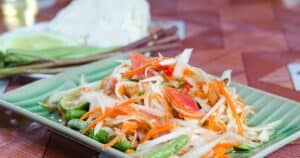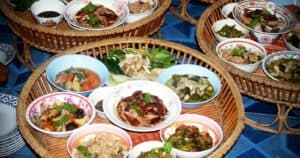Thai food is delicious, but like any leftovers, you may wonder just how long it will stay fresh and tasty in the fridge. Follow this guide to learn how long Thai food lasts in the fridge, recognize signs of spoilage, and use proper storage methods to extend the shelf life.
Quick Answer: Thai Food Fridge Life
Most leftover Thai food will last 3-4 days when stored properly in the fridge. Certain ingredients like fresh veggies may last 5-7 days. However, the flavor and texture can deteriorate quickly. Use your judgment on smell and appearance. When in doubt, toss it out.
Shelf Life of Common Thai Foods
Here are some guidelines for how long different Thai menu items will last refrigerated:
- Cooked Thai dishes like curry, noodles, fried rice – 3-4 days
- Pad Thai specifically – 3-4 days
- Takeout noodles with heavy sauce – 2-3 days (can get soggy)
- Raw ingredients like meat and veggies – 5-7 days
Always inspect leftovers before eating. Trust your senses! If it smells, looks, or tastes off, don’t risk eating it.
Freezing Leftover Thai
Want your leftovers to last even longer? Freeze them! Transfer to airtight containers or bags within 2 hours. Frozen Thai food stays safe for 2-3 months. Thaw in the fridge before reheating.
Proper Storage for Thai Leftovers
Follow these storage tips to keep Thai leftovers fresh and safe:
Refrigerate ASAP
❌ Don’t leave Thai food out more than 2 hours after cooking.
✅ Refrigerate or freeze within 2 hours to prevent bacteria growth.
Use Airtight Containers
❌ Don’t store in flimsy plastic or foils.
✅ Use airtight glass or plastic containers to keep air out.
Know Optimal Fridge Temp
❌ Avoid storing in a warm fridge above 40°F.
✅ Set fridge to below 40°F to slow bacteria growth.
Label & Track Dates
❌ Don’t guess when leftovers are from.
✅ Label containers with dates so you know when to toss.
Freeze for Long-Term
❌ Don’t keep leftovers beyond 3-4 days in the fridge.
✅ Freeze within 2 hours for storage up to 3 months.
How To Tell When Thai Food Has Spoiled
Rely on your senses to determine if Thai leftovers are past their prime:
Smell
❌ Foul, unpleasant odors
✅ Aroma similar to when freshly cooked
Texture
❌ Slimy, mushy, grainy
✅ Maintains original texture
Color
❌ Graying, mold, unnatural colors
✅ Appears as it did originally
When In Doubt, Throw It Out!
Don’t take risks with food safety. Discard leftovers that are older than 3-4 days or seem questionable in any way.
The Impact of Ingredients on Shelf Life
The types of ingredients in Thai dishes can impact how long leftovers last. For example:
- Meat and seafood have a shorter shelf life than veggies and tend to spoil faster.
- Heavy sauces and oils help prevent noodles and rice from drying out but can also make the texture soggy and unappealing quicker.
- Spices and herbs have preservative properties that help food last longer when used generously.
- Leftovers with minimal ingredients like soups may have a shorter lifespan than complex dishes.
The takeaway: Factor in what main ingredients are in a dish when determining its fridge life. Delicate proteins spoil fastest while hardy veggies and well-spiced foods may last longer.
Reheating Leftovers Properly
It’s important to reheat Thai leftovers correctly to prevent foodborne illness:
- Only reheat once – repeated reheating worsens food safety and quality.
- Use the stove, oven, or microwave – reach 165°F internal temperature.
- Stir and rotate food to distribute heat evenly – prevent cold spots.
- Bring sauces just to a simmer – don’t boil to avoid separating.
- Add a splash of water to noodles and rice to restore moisture.
The bottom line: Always reheat leftovers thoroughly and handle them safely before consuming. Don’t risk eating portions that seem questionable.
Ideal Takeout Storage
Follow these tips when bringing home takeout Thai food:
- Request extra containers so dishes with sauces can be separated.
- Try to eat takeout within 2 hours for best quality and food safety.
- Transfer takeout to airtight storage ASAP after arriving home.
- Never store takeout in hot car or leave out for extended time before refrigerating.
- If reheating takeout after fridge storage, check internal temp with a thermometer.
Key takeaway: Handle takeout carefully and swiftly when transporting it home. The quicker it can be refrigerated or consumed, the better.
Tips to Avoid Wasting Thai Leftovers
Implement these strategies to get the most out of your Thai leftovers and avoid waste:
- Store properly to extend shelf life
- Plan meals and order accordingly to prevent excess
- Use creatively in new dishes like omelets, soup, etc.
- Organize fridge so older leftovers get used first
- Portion mindfully when dining out to reduce excess
- Learn to cook Thai food at home using leftovers
Creative Ways to Use Leftover Thai Food
Put those leftovers to delicious use! Here are ideas to reinvent Thai food scraps into yummy new dishes:
Omelets
- Pad Thai Omelet – Toss noodles with eggs and fry up
Fried Rice
- Thai Basil Fried Rice – Stir fry rice, veggies, meat, Thai basil
Soups
- Tom Yum Soup – Simmer shrimp, chicken, broth, herbs
Snacks
- Thai Curry Puffs – Wrap curry in puff pastry and bake
Salads
- Thai Noodle Salad – Toss noodles with fresh veggies and herbs
Be creative and give your leftovers new life! With proper storage and inventive recipes, you can cut waste and enjoy your favorite Thai food over and over.





